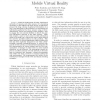1060 search results - page 109 / 212 » Clustering Distributed Time Series in Sensor Networks |
ICNP
2003
IEEE
14 years 2 months ago
2003
IEEE
Emerging large scale distributed networking systems, such as P2P file sharing systems, sensor networks, and ad hoc wireless networks, require replication of content, functionalit...
CCR
2002
13 years 8 months ago
2002
An ad hoc network is a fast deployable selfconfiguring wireless network characterized by node mobility, dynamic topology structure, unreliable media and limited power supply. Node...
ICRA
2002
IEEE
14 years 1 months ago
2002
IEEE
— With the deployment of large, distributed networks of cameras and other sensors, it is becoming necessary to also address the issue of how to effectively present the large vol...
INFOCOM
2009
IEEE
14 years 3 months ago
2009
IEEE
Abstract—We are interested in the sensor networks for scientific applications to cover and measure statistics on the sea surface. Due to flows and waves, the sensor nodes may g...
IJSNET
2006
13 years 9 months ago
2006
: In this paper, we present a two-tiered scheduling approach for effective energy conservation in wireless sensor networks. The effectiveness of this mechanism relies on dynamicall...

